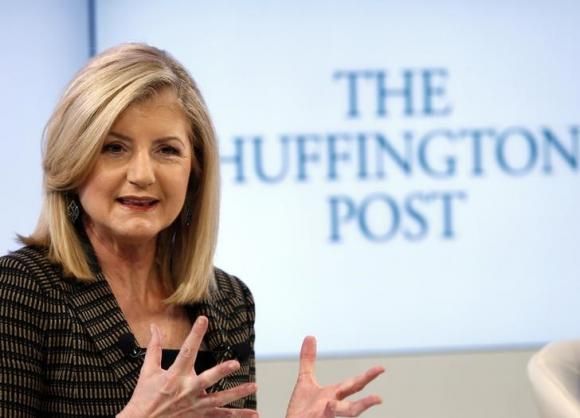 | « Back to article | Print this article |
 On Monday, Huffington Post, an 'internet newspaper' owned by the $2.3 billion AOL, launched its India edition in association with India's largest media firm, the Rs 6,700 crore or Rs 67 billion Times Group.
On Monday, Huffington Post, an 'internet newspaper' owned by the $2.3 billion AOL, launched its India edition in association with India's largest media firm, the Rs 6,700 crore or Rs 67 billion Times Group.
WPP-owned GroupM, the country's largest media agency, is a strategic partner. Vanita Kohli-Khandekar spoke to Arianna Huffington (see left) on India and a digital future. Excerpts.
Why India? What are the key drivers of your content strategy in India, the content mix you are banking on?
It is impossible to be global without being in India. We are coming at a great time in India's history.
There is talk of 4G and the new government is committed to broadband.
And our model is ideally suited to this digital explosion. HuffPost is a hybrid, a journalistic enterprise with our own reporters, as well as a global newsroom available to each of our international editions, and a platform on which thousands of people can express their opinions and tell their stories.
In terms of specific content mix, beyond covering politics, news, and business, we are very committed to covering good news.
So while we will cover relentlessly all that is dysfunctional, we will also be putting the spotlight on what is working; on start-ups, on creating jobs, non-profits, alleviating suffering - either as news stories like that on the "Robin Hood army" - a group that distributes excess food from restaurants to the poor - or as blogs, like that by a member of parliament writing about the benefits of technology as an enabler in making information available to millions.
Newspapers are the most profitable part of the media industry in India unlike the US or Europe.
India is at a different time in its digital journey, but the eyeballs and the traffic is there. It is not a matter of if, but when the digital dollars will follow.
Your arrangement with the Times Group and GroupM?
Our advertising inventory is committed to GroupM for a year. Most of our international editions (India is the 13th one) have been joint ventures.
However there is no joint venture here because of the 26 per cent cap on foreign investment. So we are working through Times Internet. It is a very natural partner and Satyan Gajwani (chief executive officer, Times Internet) is very committed to a digital future.
(Gajwani explains that the two partners will invest in the business jointly and split revenues in an undisclosed ratio).
The targets for the India market in year one - in traffic, revenues or other parameters?
We would like to be one of the top news sites in India within three-five years.
Because of all the lessons we learned in the US, in our international markets we have an accelerated timeline for profitability.
Typically, we see our editions on track to profitability within two-three years.
The challenges of the India market as you see it.
India has slower internet bandwidth on average than the other countries we've launched in, so we have to pay special attention to the user experience - including factors like page performance and bandwidth for videos
One of the reasons HuffPost has been profitable is because it runs a lot of (free) blogger content, so costs are lower. Going forward is that model sustainable?
Our biggest cost is journalists and engineers. Huffington Post is a technology media company, with innovative customer management software, a proprietary editorial dashboard and real time analytics. We use original content, bloggers and aggregation.
That has always been the model.
We had five people to start with (in 2005), now we have 800 globally, so we invest a lot in original content.
That is why we won a Pulitzer (in 2012 for military correspondent David Woods 10 part series on wounded war veterans and their families).
The vast majority of our traffic comes from the content we create ourselves.
Where is the money in digital?
Advertising is the key revenue source. But there are several new forms of advertising - native, sponsored.
For example, Johnson & Johnson is interested in global maternal help, so they would buy (ad inventory) a whole section on maternal health.
Native advertising (the online equivalent of advertorials) forms one-third of our revenues.